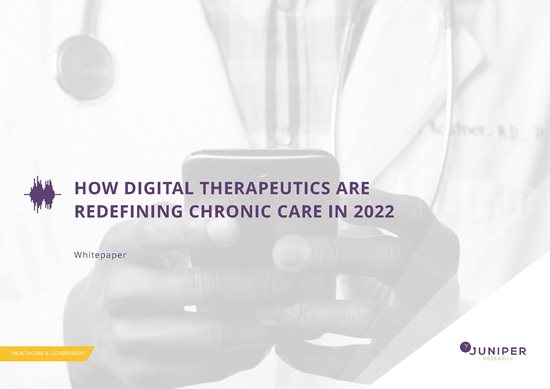Basingstoke, UK – 14th January 2019: New findings from Juniper Research reveal that wearables, including health trackers and remote patient monitoring devices, are set to become ‘must haves’ in delivering healthcare, with $20 billion forecast to be spent annually on these devices by 2023. Meanwhile, assistive hearables, or connected hearing aids made available via healthcare providers, as well as directly to customers at varying price models, will mean this sector generates revenues of over $40 billion by 2022.
The new research, Digital Health: Disruptor Analysis, Country Readiness & Technology Forecasts 2018-2023, found that adoption of healthcare wearables will be driven by improvements in remote patient monitoring technology, in addition to increased adoption by medical institutions. Juniper forecasts that 5 million individuals will be remotely monitored by healthcare providers by 2023.
Update August 2022: The above research has been replaced by Digital Therapeutics & Wellness: Market Forecasts, Key Trends & Business Models 2022-2026.
For more insights on the market readiness for digital health, download the free whitepaper: Will Digital Health be Ready for Complete AI Dominance?
The research forecasts that the advanced ability of AI-enabled software analytics to proactively identify individuals at risk of their condition worsening will witness increased confidence among medical practitioners and regulators with regard to sensor accuracy.
Wearables to Become an $855 Million Service Opportunity
As wearables become part of patients’ treatment plans, OEMs will seek to adjust their business models and generate revenues from devices being monitored. For example, selling data produced by the devices to insurance providers. Juniper forecasts that service revenues of this nature will reach $855 million by 2023.
However, data privacy and consent will continue to be a significant barrier. Improving healthcare systems, such as using AI-enabled software analytics, is contingent on patient data being anonymised. Some insurance providers are changing the dynamics. In order to be covered, they require a data feed from the policyholder’s device.
Research author Michael Larner added: “It is vital that patients are made aware of how their personal data will be used. If not, making wearables ‘must have’ to provide personalised care or receive medical insurance risks a backlash from patients and heightened regulatory scrutiny; stalling the effectiveness of remote monitoring.”
Juniper Research provides research and analytical services to the global hi-tech communications sector, providing consultancy, analyst reports and industry commentary.
For further details please contact Sam Smith, Press Relations



















